 Home
Gallery
Contact
Events & Projects
Projects: 2019 On
Film & TV
Archive & Links
Home
Gallery
Contact
Events & Projects
Projects: 2019 On
Film & TV
Archive & Links
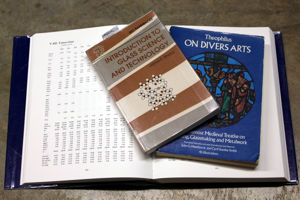
 Home
Gallery
Contact
Events & Projects
Projects: 2019 On
Film & TV
Archive & Links
Home
Gallery
Contact
Events & Projects
Projects: 2019 On
Film & TV
Archive & Links
|

|
Ordering, Postage, Payment, Import Duty & Safety
Back to Gallery
Pre 18th century Glasses
18th century Glasses
Other 18th century Vessels
Outlander Vessels
Outlander Vessels By Season
Our Reference Library for 18th century Glass
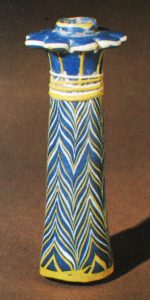 Lead in Ancient Glasses:
Lead in Ancient Glasses:
Lead has been an ingredient in glass as early as the Egyptian Bronze Age, when it was used in conjunction with antimony to produce a lead antimonate opaque yellow. Core formed vessels of the Eighteenth Dynasty (pharaohs including Ahkenaten and his son, Tutankhamun - the mid to late 14th century BC) were often decorated with lead antimonate yellow, along with calcium antimonate white and cobalt and copper blues. 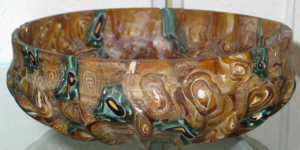 Lead antimonate yellow remained in use throughout the 1st millenium BC: it is often seen on core formed vessels and glass inlays and beads of the 5th century BC and later, and on glass vessels from the Hellenistic and Republican and early Imperial Roman periods. More rarely, it is seen on later Roman glass, such as 'Snake-thread' glass vessels from the 4th century AD.
Lead antimonate yellow remained in use throughout the 1st millenium BC: it is often seen on core formed vessels and glass inlays and beads of the 5th century BC and later, and on glass vessels from the Hellenistic and Republican and early Imperial Roman periods. More rarely, it is seen on later Roman glass, such as 'Snake-thread' glass vessels from the 4th century AD.
Although lead antimonate and lead stannate opaque yellows were used by Venetian glassmakers of the Italian Renaissance, lead has been superceded by other materials, such as cadmium sulphide. Lead is often present in opaque whites from the Hellenistic and Roman periods, notably in analyses of 1st century Roman cameo glass, such as the Portland Vase and the Auldjo Jug - both in the British Museum. The white glass of the Portland Vase body has a lead content of 12%, and that of the Auldjo Jug is 22% (Bimson and Freestone 1983, Freestone 1990). |
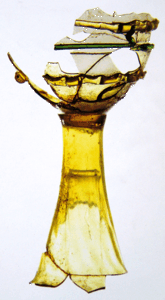 Medieval Lead Glasses:
Medieval Lead Glasses:
The earliest surviving treatises on medieval glass are from the 10th and 12th centuries. Eraclius, 'De coloribus et artibus Romanorum', from the 10th century, has a chapter added in (probably) the 12th century: ‘How glass is made of lead, and how it is coloured’. He writes of a high-lead glass of two parts lead to one part sand. Theophilus, 'De diversis artibus', from the 12th century, mentions lead glass finger rings, and a missing chapter apparently refers to using lead in (glass?) pigments. Examples of early lead glass, dating from the 9th to the 13th centuries, have been found in England, the Low Countries, Germany, Sweden and Southern Russia, and are thought to have been produced in Northern Europe and Southern Russia. Many of these are high-lead glass objects (finger rings, bangles, beads, gaming counters, mosaic tesserae and jewellery inlays) and vessels containing from 60% to 80% lead. High-lead objects and vessels from Kiev contain up to 64% lead, but other glass fragments from Kiev have a lower content of between 20% and 30% (Tyson 2000, pp.11-12). Tyson lists a group of nine or more high-lead glass goblets, with a typical transparent yellow colour due to the lead content, from sites in England dating from the 13th and early 14th centuries, including an incomplete example from Old Sarum, with parallels from Germany containing up to 84% lead (Tyson 2000, pp.17, 59-61, fig.6, Types A5 and A6). She also lists other high-lead glass tableware, including beakers (ibid. pp.82-85, fig.12, Types B10 and B11), flasks or jugs (ibid. pp.117-118, fig.20, Type D4) and some miscellaneous fragments (ibid. pp.185-186, fig.37, Type H16). |
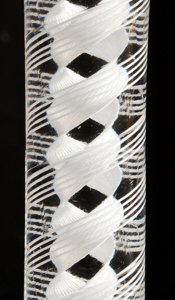 English and Irish Lead Crystal (Flint Glass):
English and Irish Lead Crystal (Flint Glass):
Lead crystal was commercially developed by George Ravenscroft in the late 17th century, and in 1674 he was granted a Royal patent to produce and sell glass vessels made from it. The term 'flint glass' was in use because the original source for the silica was calcined flints, and does not necessarily mean that lead was a component of the glass. Recipes for high lead glasses had been written down by this time. In 1651, Glauber published his 'New Philosophical Furnaces', containing recipes for high lead glass and a glass made by combining high lead glass with 'Venice glass', and both Newton and Boyle noted recipes down in their laboratory notebooks. In 1662, Merret published a copiously annotated translation of Neri's 'L'Arte Vetraria (Art of Glass)' of 1612, which contained recipes for high lead glass for imitation jewels. Ravenscroft may have made use of this information, helped by an Altarist glassmaker, Johan van Barmont Baptista Da Costa, who had peviously worked in Nimegen with, amongst others, Jor Odacio, also from Altare. Odacio established a glasshouse in Dublin and applied for and was granted a similar patent to Ravenscroft's in 1675. Both of these glassmakers may have brought the knowledge of glassmaking using lead to their respective new homes (Brain 2008, p.112; Dungworth and Brain 2009, p.112 (also!)). The glass Ravenscroft used for his first products was chemically unstable and within a short time started to crizzle (devitrify). He corrected this by increasing the lead oxide content, thereby creating a more chemically stable glass. Over the years of the late 17th century, increasing amounts of lead were added to glass, both during the Ravenscroft period in order to counter the crizzling problem, and after he had retired from glassmaking in 1679 (although his brother, Francis Ravenscroft continued at the Savoy glasshouse in London until the patent finally expired in 1681). Dungworth and Brain have identified four groups of late 17th century lead crystal compositions, based on lead content vs. potassium content, both during (Group 1 (16.4% lead) and Group 2 (27.2% lead)) and after (Group 3 (34.5% lead) and Group 4 (39.9% lead)) the Ravenscroft period (Dungworth and Brain 2009, p.125 et seq.). There is evidence that during the 18th century, the lead content in lead crystal settled to between 34% and 40%. In a small set of twenty samples of 18th century glass, lead content averaged 37.38%, with a range of 34.11% to 39.95% (Colin Brain: pers. comm.). The first tax on glass, introduced in 1695, was calculated on the weight of the glass produced at each glasshouse (as was the second tax, imposed between 1745 and 1845), and this appears to be the reason for the reduction in the amount of lead at the end of the 17th century. Quick calculations on recipe nos. 57, 61, 68, 71, 78 and 81 (chosen at random) from Gillinder (Gillinder 1851) give an average lead oxide content of 34%, an indication of the normal lead crystal compositions during the 19th century. During the 20th century, and into the 21st century, two commonly used amounts of lead in lead crystal have been 24% and 30%. Lead contents of 30% and more are known as 'English Full Lead Crystal'. |
|
Properties of Lead Crystal Glass and Use of Lead in Glassworking:
Lead, added as litharge (PbO) or as red lead or minium (Pb3O4) imparts several useful properties to the resulting glass.
Lead oxide has been a traditional material for marking out and polishing cut and engraved glass. In the 18th century, it was also used as one of the ingredients of the glue used in gilding drinking glasses (Charleston 1972, p.22). A modern use for lead in glass is in radiation shielding. |
|
Disadvantages:
There are several disadvantages to using lead in glass:
UK medical website
Lead Crystalware and your Health (Health Canada 2003) – recommends soaking new lead crystal in vinegar for 24 hours before using it as it leaches lead from the surface of the glass, and only washing it by hand, using a mild detergent. Lead, Glass, and the Environment (Hynes and Jonson 1997) – also mentions the leaching property of vinegar. Of the leaching by wine, they write (p.144): "Typical 24% PbO crystal currently manufactured can be expected to leach ca.10pg Pb during three 1hr contacts of 150ml of wine per contact (a total of 450ml). Most of the leaching occurs during the first two contacts so that successive contacts will not significantly increase the lead intake. These conditions represent an extreme case in view of the quantity ingested and the contact time. However, such an intake does not present any undue risk to the average adult, particulary in view of the fact that lead absorption during meals is less than 10%." NB 1pg (1 picogram) is equal to one trillionth of a gram (10-12gm). One has to remember, though, that there are many other hazardous ingredients used in glassmaking, and they all require sensible handling. Both hot and cold glassworking have their dangers, whether or not lead is used. |
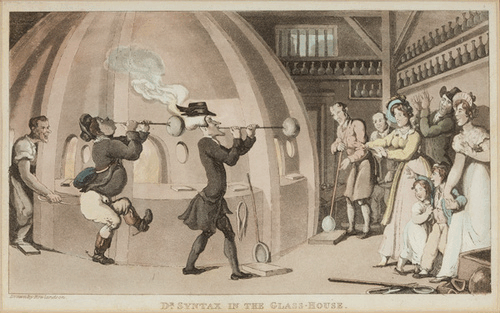
'Dr Syntax in the Glasshouse' (1820) by Thomas Rolandson, from 'The Second Tour of Dr Syntax in Search of Consolation' |
|
References:
Bimson, M. and Freestone, I. C. (1983) 'An Analytical Study of the Relationship Between the Portland Vase and Other Roman Cameo Glasses' Journal of Glass Studies Vol.25, pp.45-54. The Corning Museum of Glass: Corning, New York
|
Home Gallery Contact Events & Projects Projects: 2019 Onwards Film & TV Archive & Links